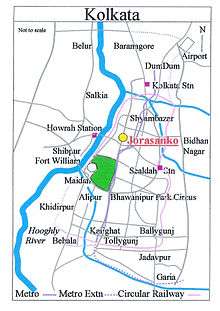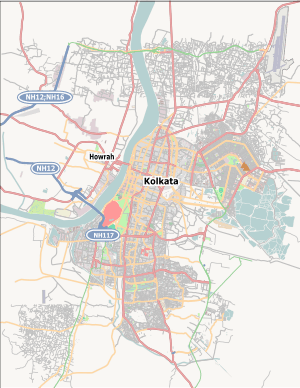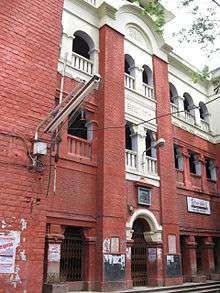Jorasanko
| Jorasanko | |
|---|---|
| Neighbourhood in Kolkata (Calcutta) | |
 | |
 | |
 Jorasanko Location in Kolkata | |
| Coordinates: 22°35′08″N 88°21′24″E / 22.5855°N 88.3568°ECoordinates: 22°35′08″N 88°21′24″E / 22.5855°N 88.3568°E | |
| Country |
|
| State | West Bengal |
| City | Kolkata |
| District | Kolkata |
| Metro Station | Girish Park |
| Municipal Corporation | Kolkata Municipal Corporation |
| KMC wards | 22, 23, 41 |
| Government | |
| • MLA | Dinesh Bajaj |
| Elevation | 36 ft (11 m) |
| Time zone | UTC+5:30 (IST) |
| PIN | 700 007 |
| Area code(s) | +91 33 |
| Lok Sabha constituency | Kolkata Uttar |
| Vidhan Sabha constituency | Jorasanko |
Jorasanko is a neighbourhood of north Kolkata, in Kolkata district, West Bengal, India. It is so called because of the two (jora) wooden or bamboo bridges (sanko) that spanned a small stream at this point.
History
Apart from the distinguished seat of the Tagore family, traditionally known as the Jorasanko Thakur Bari, it was also home of the Singhas (including Kaliprasanna Singha), the Pals (including Krishnadas Pal), and the families of Dewan Banarasi Ghosh,Gokul Chandra Daw, Narsingha Chandra Daw, Prafulla Chandra Gain, and Chandramohan Chatterji. “The area thus became the cradle of Bengal Renaissance.”[1] It was earlier known as Mechuabazar.[2]

The earliest list of thanas (police stations) in Kolkata was prepared in 1785 for both police and municipal administration. Jorasanko was one of the 31 thanas then recorded.[1]
Amongst the institutions in Jorasanko are – Adi Brahmo Samaj, the Jorasanko Bharati Natya Samaj, the Kalikata Haribhakti Pradayani Sabha, the Minerva Library and Oriental Seminary.[1] The Oriental Seminary started in 1829 by the educator Gour Mohan Addy, was one of the earliest privately run, first-rate, Hindu supported modern school in Kolkata, open to middle and lower middle-class Hindu boys only.[3]
Rabindra Bharati University, the third university in Kolkata, was set up in 1962 in the Tagore family’s house at Jorasanko, primarily as a centre for music and fine arts, but extended subsequently to arts and humanities.[4]
In 1888, one of the 25 newly organized police section houses was located in Jorasanko.[5]
Rabindra Sarani
Jorasanko is located on Rabindra Sarani (earlier Chitpore Road.) “The great thoroughfare, which commencing in the extreme south, assumes the various names of Russa Road, Chowringhee Road, Bentick Street, Chitpore Road, and Barrackpore Trunk Road, forms a continuation of the Dum Dum Road and was the old line of communication between Morshedabad and Kalighat. It is said to occupy the site of the old road made by the Sabarna Roy Choudhurys, the old zemindars of Calcutta, from Barisha, where the junior branch resided, to Halisahar, beyond Barrackpore, which was the seat of the senior branch.” [6] Some people refer to the entire stretch through which Chitpore Road ran as Chitpore or Chitpur. That includes Jorasanko.
Jorasanko Natyashala
There were two Jorasanko Natyashalas. The earlier one was organised by Peary Mohan Bose at his house on Banarasi Ghose Street, in Jorasanko. The only play staged was Shakespeare’s Julius Caeser on 3 May 1854.[7]
Ganendranath Tagore established the second Jorasanko Natyasala, a home theatre, in 1865 and staged Krishnakumari written by Michael Madhusudan Dutta that year itself. Young Jyotirindranath had the first opportunity to act in it in the role of Ahalyadevi.[8] At first men played women’s roles, but subsequently women of the family also acted before an audience of friends and relatives and even late before the public.[2]
As there were few good plays in Bengali, which could be taken up for staging, Ganendranath announced a prize for writing plays. Nabanatak written by Ramnarayan Tarkaratna won the first prize. He awarded the playwright Rupees two hundred (a large sum in those days) and promised to bear the cost of printing a thousand copies of the play.[9][10]
Recent developments
Buddhadev Dasgupta won the award for the Best Direction for the Year 2001 for the film Jorasanko Thakurbari for artistically unfolding the history of the house of the Tagores.[11] Joanne Taylor who has written a book on the Forgotten Palaces of Calcutta was spell bound by the Jorasanko Thakur Bari. “These structures form the fabric of Kolkata’s history,” she says.[12]
Jorasanko is an important centre of shell industry in Kolkata.[13] However, the industry has not been in good shape in recent years.[14]
Geography
Police district
Jorasanko police station is part of the Central division of Kolkata Police. Located at 16, Bal Mukund Malkar Road, Kolkata-700007, it has jurisdiction over the police district which is bordered on the north from the north-east corner of the junction of Muktaram Babu Street and Rabindra Sarani (old Upper Chitpur Road), thence eastward along the northern limit of Muktaram Babu Street up to the North-west corner of the junction of Muktaram Babu Street and Chittaranjan Avenue, thence crossing Chittaranjan Avenue eastward up to the North-east corner of the junction of the Muktaram Babu Street and Chittaranjan Avenue thence eastward along the northern limit of Muktaram Babu Street up to the north-west corner of the junction of Muktaram Babu Street and Bidhan Sarani (old Cornwallis Street), thence crossing Bidhan Sarani eastward up to the north east corner of the junction of Bidhan Sarani (old Cornwallis Street) and Muktaram Babu Street. On the east, it is bordered from the north-east corner of the junction of Bidhan Sarani (old Cornwallis Street) and Muktaram Babu Street, thence south-ward along the eastern limit of Bidhan Sarani and College Street to Surya Sen Street (old Mirzapur Street) up to the north east corner of the junction of Surya Sen Street (old Mirzapur Street) and College Street. On the south, it is bordered rom the north-east corner of the junction of Surya Sen Street (old Mirzapur Street) and College Street, thence crossing College Street west ward to the northwest corner of the junction of College Street and Angarika Dharmapal Street (old Colootola Street), thence westward along the northern limit of Anagarika Dharampal Street (old Colootola Street) up to the north east corner of Anagarika Dharampal Street (old Colootola Street) and Chittaranjan Avenue thence westward crossing Chittaranjan Avenue up to north-west corner of Maulana Saukat Ali Street (old Colootola Street) and Chittaranjan Avenue, thence westward along the northern limit of Maulana Saukat Ali Street (old Colootola Street) up to the north-east corner of the Maulana Saukat Ali Street (old Colootola Street) and Rabindra Sarani (old Lower Chitpur Road). On the west, it is bordered rom the north-east corner of the junction Maulana Saukat Ali Street (old Colootola Street) and Rabindra Sarani (old Lower Chitpur Road), thence northward along the eastern limit of Rabindra Sarani to Muktaram Babu Street, thence crossing Muktaram Babu Street northward up to the north-east corner of the junction of Muktaram Babu Street and Rabindra Sarani (old Upper Chitpur Road).[15]
Taltala Women police station covers all police districts under the jurisdiction of the Central division i.e. Bowbazar, Burrabazar, Girish Park, Hare Street, Jorasanko, Muchipara, New Market, Taltala and Posta.[15]
Gallery
 Posters adorn the offices of Jatra groups
Posters adorn the offices of Jatra groups
 Sugar Cane for sale for Rath Yatra on a Jorasanko footpath
Sugar Cane for sale for Rath Yatra on a Jorasanko footpath A litho printer at work – a Jorasanko speciality
A litho printer at work – a Jorasanko speciality
References
| Wikimedia Commons has media related to Jorasanko. |
- 1 2 3 Nair, P. Thankappan in The growth and Development of Old Calcutta in Calcutta, the Living City, Vol I, edited by Sukanta Chaudhuri, pp. 15 - 17, Oxford University Press, ISBN 0-19-563696-1.
- 1 2 Deb, Chitra, Jorasanko and the Thakur Family, in Calcutta, the Living City, Vol I, edited by Sukanta Chaudhuri, pp. 64-66, Oxford University Press, ISBN 0-19-563696-1
- ↑ Kopf, David, The Brahmo Samaj and the Shaping of the Modern Indian Mind, p 49, Princeton University Press.
- ↑ Chaudhuri, Sukanta, in Education in Modern Calcutta in Calcutta, the Living City, Vol II, edited by Sukanta Chaudhuri, p 205, Oxford University Press, ISBN 0-19-563697-X.
- ↑ Nair, P.Thankappan, The Growth and Development of Old Calcutta, in Calcutta, the Living City, Vol. I, pp. 18-19, Edited by Sukanta Chaudhuri, Oxford University Press, 1995 edition.
- ↑ Cotton, H.E.A., Calcutta Old and New, first published 1909, revised edition 1980, p 283, General Printers and Publishers Pvt Ltd.
- ↑ Mukhopadhyay, Ganesh (2012). "Theatre Stage". In Islam, Sirajul; Jamal, Ahmed A. Banglapedia: National Encyclopedia of Bangladesh (Second ed.). Asiatic Society of Bangladesh.
- ↑ Bannerjee, Hiranmay, Thakurbarir Katha, (in Bengali), p.103 , Sishu Sahitya Sansad.
- ↑ Bannerjee, Hiranmay, p. 219.
- ↑ Sengupta, Subodh Chandra and Bose, Anjali (editors), 1976/1998, Sansad Bangali Charitabhidhan (Biographical dictionary) Vol I, (in Bengali), p. 127, ISBN 81-85626-65-0
- ↑ "49th National Film Award". Award for the Best Direction. Press Information Bureau, Government of India. Retrieved 2007-04-24.
- ↑ Paul, Mathures. "Charming Bricks". Kolkata Unplugged. The Statesman. Archived from the original on 2007-09-29. Retrieved 2007-04-24.
- ↑ "Shell Craft of West Bengal". Crafta and artisans of India. Craftsandartisans.com. Retrieved 2007-04-24.
- ↑ "A little more help needed but…". Bengal Plus. The Statesman, 10 April 2007. Archived from the original on 26 September 2007. Retrieved 2007-04-24.
- 1 2 "Kolkata Police". Central Division. KP. Retrieved 9 March 2018.
External links
![]()